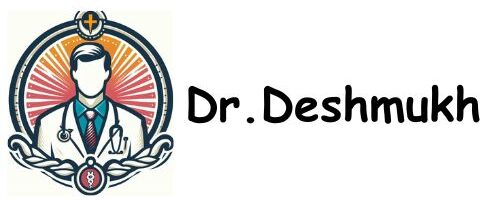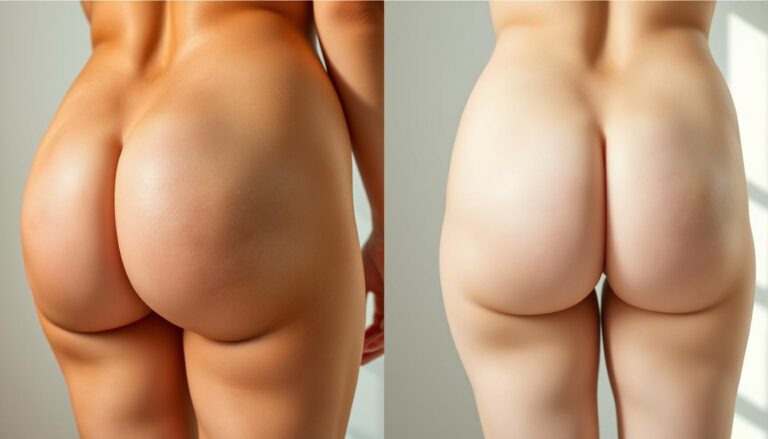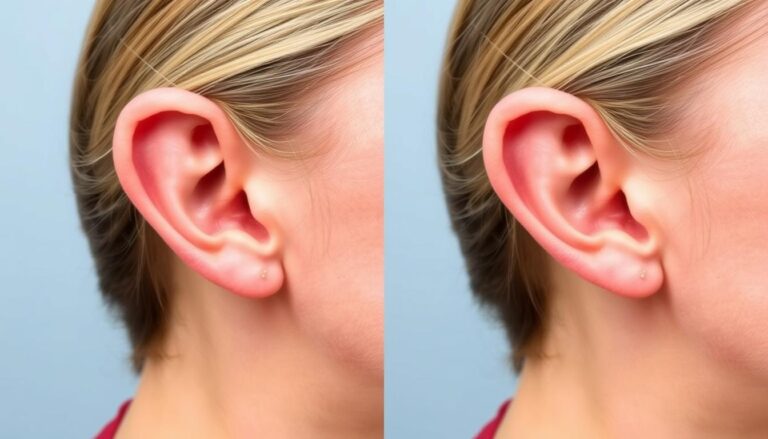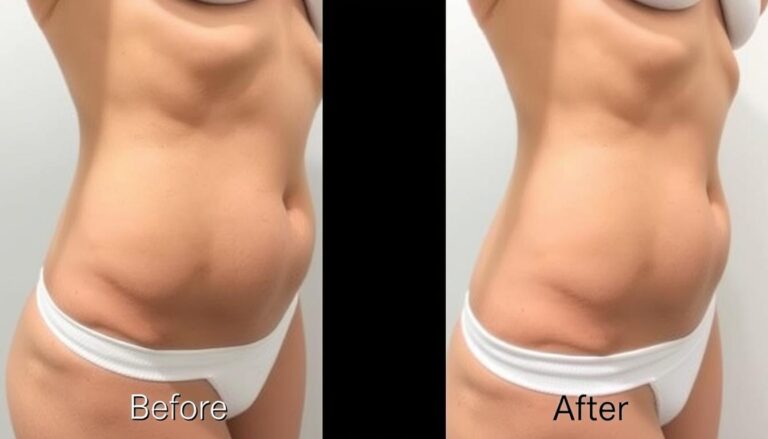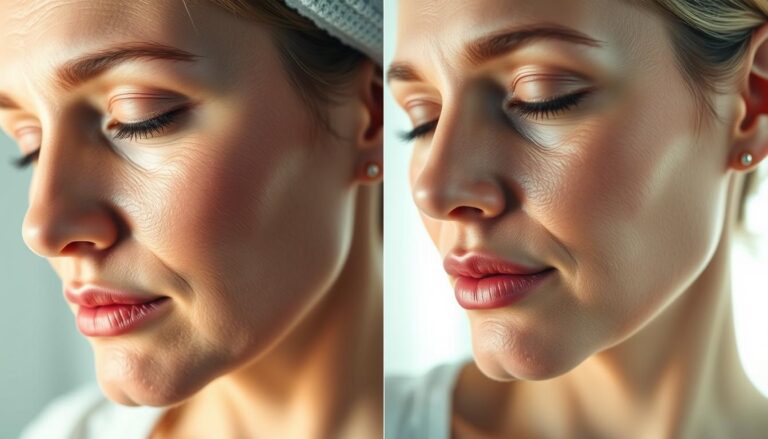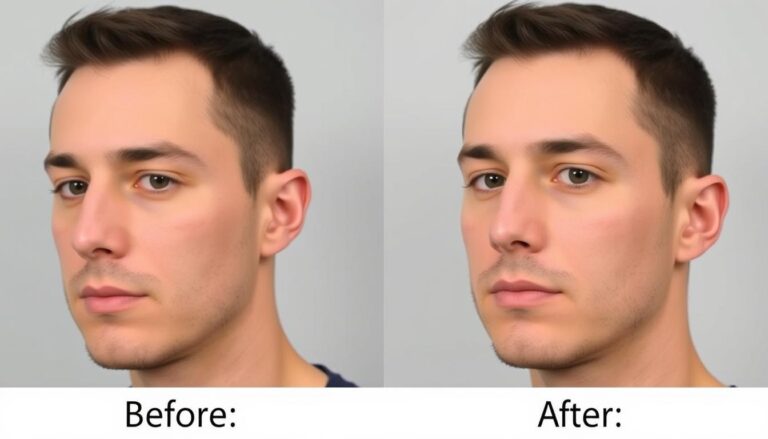Beard Transplant Before and After: Real Results
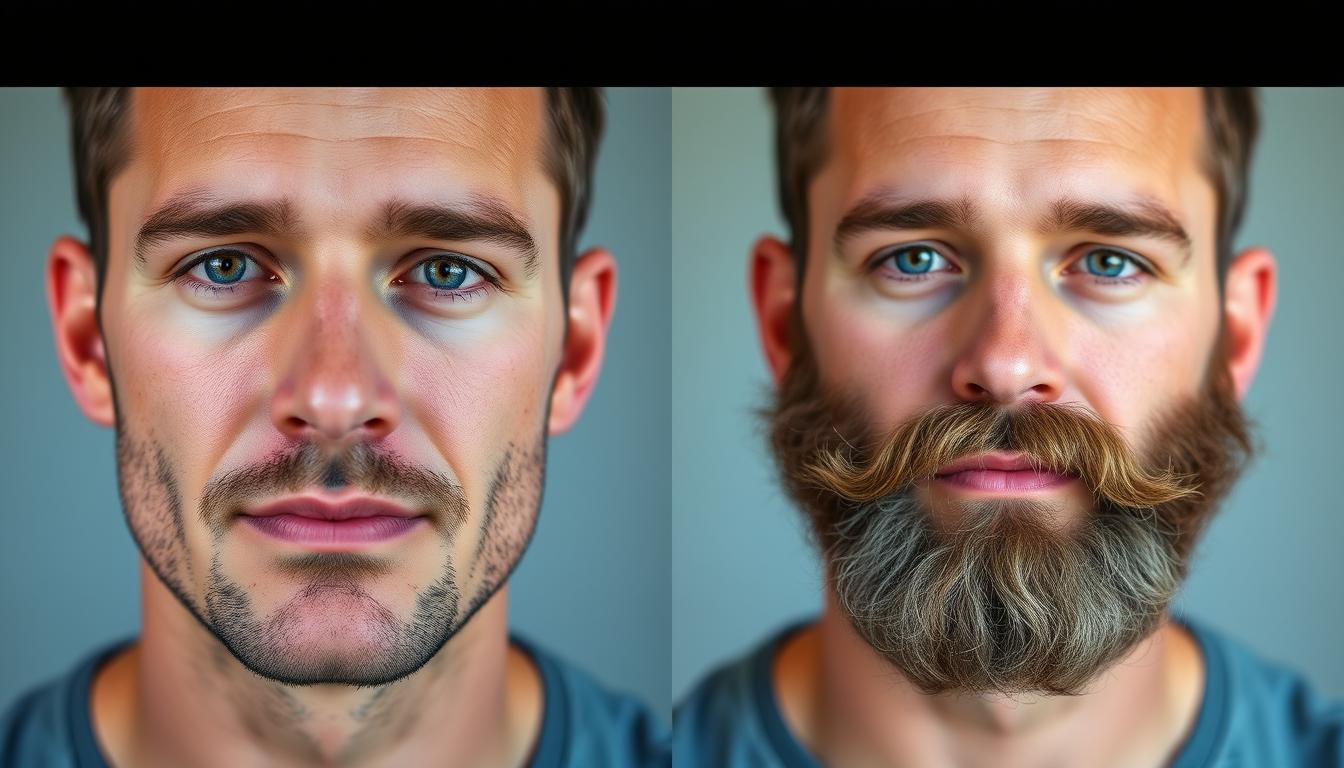
Did you know a beard transplant in the U.S. can cost up to $15,000? More men are looking to improve their facial hair. Beard transplant surgery is a popular choice for those with patchy or thin beards.
These surgeries offer a lasting fix for thinning beards. They also boost self-confidence by making beards look fuller and more natural.
At places like Cosmedica Clinic in Turkey, beard transplants are both effective and affordable. Patients see amazing changes. The before and after photos are truly striking.
In this article, we’ll explore beard transplantation in detail. We’ll look at its techniques, who it’s for, and the amazing transformations it brings.
Table of Contents
What is a Beard Transplant?
A beard transplant is a surgical treatment to grow more facial hair. It moves hair follicles from the scalp to the beard area. Knowing what a beard transplant definition is key for those facing facial hair loss.
Definition of the Treatment
This treatment aims to make your beard fuller and more defined. Hair follicles are moved to the beard for natural-looking results. The transplanted hairs last a lifetime, offering long-term benefits.
Types of Beard Transplant Techniques
There are several beard transplant techniques to choose from. Each has its own benefits. The main methods are:
- Follicular Unit Extraction (FUE): This method takes out individual hair follicles and plants them in the beard. It’s precise, making hair growth look natural.
- Follicular Unit Transplantation (FUT): This involves taking a strip of hair follicles and breaking them into individual grafts. It’s good for covering larger areas.
The right technique depends on the patient’s needs and preferences. The success of the transplant also depends on how well it matches the natural hair growth. Many patients are very happy with their beard transplant results.
| Technique | Method | Pros | Cons |
|---|---|---|---|
| Follicular Unit Extraction (FUE) | Individual hair follicle extraction | Minimally invasive, quick recovery | Requires high precision |
| Follicular Unit Transplantation (FUT) | Strip harvesting method | Effective for larger areas | Slightly longer recovery time |
Who Needs a Beard Transplant?
Knowing who might need a beard transplant is key for those thinking about it. Many factors, like genetics and hormonal changes, can cause thin or patchy facial hair. Those looking for a beard transplant often have certain traits that make them good candidates.
Candidates for Treatment
Typically, the right candidates for a beard transplant are:
- People with thin or patchy facial hair.
- Those unhappy with their facial hair due to genetics.
- Individuals who have had skin issues that affect hair growth.
- Men wanting to improve their facial look.
Many of these candidates want to feel better about themselves and look more masculine. A beard transplant can greatly change their look, making their facial hair fuller and more youthful.
Reasons for Undergoing the Procedure
There are many reasons to get a beard transplant:
- To make facial hair look fuller and more even.
- To get a thicker beard for looks.
- To grow back facial hair lost due to hormones.
- To improve personal style and self-image.
Choosing to get a beard transplant often boosts confidence. It’s also a way to deal with hair loss due to hormones. For more on hormone therapy, check out this link.
| Criteria | Details |
|---|---|
| Age Range | Typically between late twenties to late forties |
| Hair Loss Type | Patchy, thinning, or uneven facial hair |
| Desired Outcome | Fuller, thicker facial hair |
| Mental Well-being | Increased confidence and self-esteem |
In summary, finding the right candidates for beard transplants involves genetics and personal goals. The reasons for getting a beard transplant are many, from looking better to feeling more confident. It’s a big choice for many men.
The Beard Transplant Procedure
The beard transplant procedure has several key steps for great results. First, a detailed consultation is done to see if the treatment is right for you. Then, hair follicles are taken from the scalp and carefully placed in the beard to make it fuller and look better.
Overview of Steps Involved
- Initial consultation and assessment of beard growth.
- Harvesting hair follicles from the donor site.
- Implantation of follicles in the beard area.
Duration of the Surgery
The time needed for a beard transplant depends on how many grafts are used. Most take four to eight hours. Smaller procedures might only take two to four hours. After the surgery, you’ll start to see growth in three to six months.
Technology Used in Beard Transplants
New technologies have made beard transplants better, especially with Follicular Unit Extraction (FUE). This method leaves almost no scars. Using robots in the transplant makes it even more precise, leading to better results. These advances have made patients very happy with their transplants.
Pre-Treatment Care
Before a beard transplant, it’s key to take care of yourself. This starts with a consultation where you talk about what you want, your health history, and any worries. Knowing your needs helps make a treatment plan just for you.
Consultation Process
The consultation is a big step for both you and the surgeon. They might do function tests to see if you’re a good candidate. They check your hair density, scalp health, and look for any health issues that could affect the surgery.
Talking openly about your past health and what you hope to achieve helps everyone understand what to expect. It also helps spot any possible challenges.
Required Tests and Assessments
Before the surgery, you might need to do some tests. You’ll be told to stop taking certain medicines like aspirin and ibuprofen two weeks before. This is to lower the risk of bleeding.
They might also ask for blood tests to check your health and make sure you’re ready for the surgery. Listening to your surgeon’s advice is important for the best results.
Guidelines to Follow
Following certain beard transplant guidelines can make a big difference. You’ll likely be told not to drink alcohol or smoke for a week before and after the surgery. This helps your body heal better.
After the surgery, using ice packs or frozen peas can help reduce swelling. It’s also important to avoid heavy lifting or bending for a week. These steps help you heal well and make the transplant successful.
| Guideline | Duration | Purpose |
|---|---|---|
| Stop blood thinners (aspirin, ibuprofen) | 2 weeks before | Reduce bleeding risk |
| Avoid alcohol and smoking | 1 week before and after | Enhance healing |
| Apply ice packs | Post-procedure | Minimize swelling |
| Avoid strenuous activities | 1 week after | Prevent complications |
| Follow up with prescribed medications | As directed | Manage pain and prevent infection |
Before and After Treatment Pictures
Before and after photos are key to seeing how beard transplants work. They show how patients go from sparse facial hair to fuller beards. The beard transplant before after photos show big changes in 6 to 14 months. This helps people know what to expect.
Examples of Real Transformations
There are many different results from beard transplants. This is because everyone’s goals and situations are different. For some, a fuller beard makes them feel more confident.
The number of grafts used can vary from 1,000 to 2,500. This means the results can vary too. But, many clinics say most patients are very happy with their new beards.
Importance of Visualizing Results
Seeing the beard transplant results is crucial for those thinking about it. Before and after pictures show how a beard transplant can change your look. They give hope and motivation.
Talking to experts about what to expect can also help. You can find more information on available resources.
| Months Post-Procedure | Average Visibility of Results | Percentage of Patient Satisfaction |
|---|---|---|
| 0-3 Months | Minimal | 50% |
| 4-6 Months | Moderate | 70% |
| 7-12 Months | Significant | 85% |
| 12+ Months | Full | 90% |
Post-Treatment Care
After a beard transplant, patients start a key recovery phase. It’s important to care for the area well to get the best results. Knowing the recovery time and following good tips can help a lot.
Recovery Timeline
The healing time after a beard transplant is several months. In the first days, you might feel redness, itching, and swelling. Here’s what you can expect:
- Week 1: Redness and swelling start to go away.
- Weeks 1-2: You might lose some of the transplanted hair.
- Weeks 3-4: You might start to see new hair growth.
- Months 1-2: The new hair follicles will start to thicken.
- Month 3: Your beard will start to look fuller and more even.
- Months 6-12: Your beard will look fully natural and thick.
Seeing your transplant specialist regularly is important. They can check on your healing. Following post-treatment beard care tips is key for a smooth recovery.
Tips for Safe Healing
During recovery, using smart tips can help a lot. Here are some important ones:
- Avoid direct sun for a few months to protect your skin and hair follicles.
- Don’t do too much exercise to avoid messing with your new hair.
- Eat well to help your body heal.
- Use soft cleansers and avoid rubbing the area to keep your hair healthy.
- Drink plenty of water and try to relax to help your body heal faster.
By following these tips, you can make your beard grow fuller and thicker. This will boost your confidence and style. Taking good care of your beard after the transplant is very important.
Potential Risks and Side Effects
Beard transplantation is becoming more popular. People want to improve their facial hair. Knowing the risks is key for making smart choices. Understanding what to expect helps avoid problems during recovery.
Common Risks Associated
Beard transplants come with some risks. Common side effects include:
- Hair shedding
- Swelling and redness
- Numbness and tightness
- Scarring at both donor and recipient sites
- Temporary itching and pain
Scarring depends on the procedure. For example, FUE usually causes less scarring than FUT. Most side effects go away in a few weeks. But, infections can happen. For more on treatments, check here.
How to Minimize Complications
To avoid problems, follow your surgeon’s advice carefully. Important steps include:
- Avoiding sun exposure to protect healing skin
- Staying hydrated throughout the recovery period
- Refraining from smoking to promote better healing
- Attending regular follow-up appointments for monitoring and support
Infections can happen, usually within three to seven days. They can cause hair loss or lower transplant success. Look out for signs like bleeding, redness, pain, or fever. If you notice these, get medical help right away.
Recommended Products for Pre and Post Treatment
Getting the right care before and after a beard transplant is key. It helps with hair growth and skin healing. Choose grooming and skincare products that support hair and skin health.
Grooming Essentials
After surgery, keeping up with grooming is important. You’ll need:
- Gentle shampoos: Use shampoos without sulfates to clean your hair gently.
- Beard oils: Look for oils that help your beard grow and stay moisturized.
- Conditioners: A good conditioner keeps your hair soft and easy to manage.
- Combs and brushes: Choose wide-tooth combs to avoid damaging the new hair.
Skincare Products for Healing
Good skincare is vital for healing. Here are some must-haves:
- Moisturizers: Use lotions to keep your skin moist until the scabs heal.
- Antibiotic ointments: Apply these as your doctor advises to prevent infection.
- Hydrating serums: Serums with vitamins help your skin heal and stay healthy.
Using these grooming and skincare products will help you get the best results. Also, eat well with lots of proteins, vitamins, and veggies. This will help your skin and hair. For more health tips, see Ayurvedic ways to boost your health during recovery.
Alternative Treatments for Facial Hair Loss
Beard transplants are a lasting fix for those wanting to boost their facial hair. But, there are other beard growth alternatives to consider. These include medicines, creams, and natural remedies. Looking into these options helps people make smart choices about their hair growth.
Medications and Topical Treatments
Minoxidil, known as Rogaine, is a top pick for hair growth. It’s applied twice a day for at least three months. Finasteride is another choice, which stops DHT from forming. This might help hair grow better. Dr. Alan Bauman says it’s key to find a treatment that fits your needs.
Natural Remedies and Their Effectiveness
Many people try natural ways to grow facial hair, avoiding drugs. Some popular methods include:
- Essential oils like rosemary and peppermint might help hair follicles.
- Beard oils from natural stuff can make hair healthier and grow more.
- Eating more protein and Biotin can help hair health.
Some folks say these natural remedies for facial hair work well. But, results can differ a lot. Talking to a hair expert can help figure out the best approach for you.
| Treatment Type | Description | Effectiveness |
|---|---|---|
| Minoxidil | Topical treatment promoting hair growth. | High |
| Finasteride | Oral medication blocking DHT. | Moderate to High |
| Essential Oils | Natural oils that may enhance circulation. | Varied |
| Beard Oils | Products to nourish and condition facial hair. | Varied |
| Dietary Changes | Enhanced nutrition to support hair health. | Low to Moderate |
Average Cost of Beard Transplant
The cost of a beard transplant varies based on several factors. It’s important to understand these factors if you’re thinking about getting a transplant.
Factors Influencing Pricing
Several things affect the cost of a beard transplant:
- Experience of the Surgeon: More experienced surgeons charge more because of their skill.
- Location: Prices are higher in big cities like those on the East and West Coasts.
- Technique Used: Different transplant methods cost differently.
- Number of Grafts Required: A mustache needs 350 to 500 grafts. A full beard needs almost 2000, which increases the cost.
In Miami, the average cost for a beard transplant is $3,000 to $15,000. This reflects the different factors.
Financing Options Available
Many find the initial cost of a beard transplant too high. But, there are financing options to help. Clinics like the Foundation for Hair Restoration offer payment plans. They also accept CareCredit to make payments easier.
Insurance usually doesn’t cover cosmetic procedures like beard transplants. But, some might get coverage if it’s for reconstructive reasons, like scars or burns.
| Transplant Type | Average Cost | Grafts Required |
|---|---|---|
| Partial Beard Transplant | $3,000 – $7,000 | 350 – 500 |
| Full Beard Restoration | $7,000 – $15,000 | ~2000 |
Looking into financing options makes beard transplants more accessible. It means more people can get the facial hair they want.
How to Find Treatment Near You
Finding the right beard transplant clinic can be both challenging and rewarding. Start by looking at local options with good reputations. Check out reviews and before-and-after photos from past patients. A clinic’s website often shows success stories, helping you see what to expect.
Researching Local Clinics
Finding the right clinic takes more than a quick search. Here are some steps to follow:
- Reviews and Testimonials: Look for real feedback from past clients to see how happy they were.
- Consultation Opportunities: Find clinics that offer free consultations with experienced surgeons.
- Clinic Credentials: Check the qualifications and experience of the medical team.
- Technology and Techniques: Ask about the methods used, like the FUE technique for hair transplants.
Questions to Ask During Consultations
Your first meeting with a beard transplant surgeon is key. Be ready to ask important questions. This will help you make a well-informed choice. Some key questions include:
- What is your experience with beard transplants?
- How many procedures have you performed?
- Can you show before-and-after photos of your previous patients?
- What are the possible risks and side effects?
- What should I expect during the recovery process?
Spending time to find the right clinic and asking the right questions is crucial. Look into places like Solve Clinics, known for their affordable prices and travel help. They offer $5 per graft for out-of-state patients, covering travel costs. With prices starting at $3,000, they meet various needs.
Success Stories and Testimonials
Beard transplants have changed lives for many. They share how a fuller beard boosted their self-image and confidence. These stories show how a beard can make a big difference in how people feel about themselves.
Real-Life Experiences
Many patients have shared their journeys with beard transplants. A 40-year-old man got a beard-to-beard FUE transplant to fix hair loss from a bad chin implant. This made his beard thicker and boosted his confidence in social situations.
A 36-year-old patient got a corrective hair transplant using FUT to fix a bad FUE result. This shows how tailored treatments can improve one’s look and self-esteem.
Impact of Beard Transplants on Confidence
Most patients feel more confident after their treatments. They thank the change in how they see themselves. Many say they feel more attractive and have better social interactions.
A patient who had a salvage hair transplant after a previous bad result says it opened new doors in his life. Beard transplants are not just about looks; they also boost mental health and self-esteem.
Reading patient testimonials shows how beard transplants can change lives. With a 95% success rate, the journey is worth it for many. Each story highlights the power of modern hair restoration, leading to a new sense of self and confidence.
| Case Number | Patient Age | Procedure Description |
|---|---|---|
| 90514 | N/A | Corrected 3,000 graft FUE case |
| 84962 | 40 | Beard-to-beard FUE transplant |
| 84745 | 79 | Temporal hair transplant |
| 70487 | N/A | Beard FUE salvage transplant |
| 70967 | 36 | Corrective FUT hair transplant |
| 69756 | N/A | Corrected 4-mm large scalp plugs |
| 68961 | 44 | Corrective LSE hair transplant |
Conclusion
A beard transplant can change a person’s look in big ways. It uses methods like Follicular Unit Extraction (FUE) and Direct Hair Implant (DHI). These are less invasive, which means less scarring and quicker healing.
Knowing what happens before and after the surgery is key. It helps you get the look you want.
Summary of Key Points
The surgery usually takes 4 to 8 hours. You’ll see your new look in 8 to 12 months. People choose it for many reasons, like genetics or personal style.
It’s important to talk to experts and get ready for the process. This will help you make the right choice.
Encouragement to Explore Options
Every person is different, and beard transplants can boost your confidence. Do your homework, talk to experts, and learn about the methods. This way, you can make a smart choice for lasting results.
Start your journey today. Take the first step towards your grooming dreams!
FAQ
What is a beard transplant?
Who are the ideal candidates for a beard transplant?
What techniques are used during a beard transplant?
How long does the beard transplant procedure take?
What can I expect in terms of recovery after the procedure?
Are there risks associated with beard transplants?
How much does a beard transplant cost?
How can I find the best beard transplant surgeon?
What post-treatment products do you recommend?
What are some alternatives to beard transplants?

